Gender Roles in South Asia: Cultural Norms and Societal Impact
VerifiedAdded on 2022/08/12
|8
|2173
|14
Essay
AI Summary
This essay provides an anthropological analysis of gender roles in South Asia, examining the influence of culture, societal norms, and religious beliefs on the lives of individuals. It explores the historical context of gender discrimination, highlighting disparities between male and female roles within families and communities. The essay delves into the concept of gendered spaces, discussing the emergence and social significance of the 'hijra' community in South Asia. It references the importance of culture, religion, and traditional values in shaping gendered identities and behaviors, ultimately underscoring the need for a more egalitarian society. The author, drawing from personal experiences, provides insights into the pervasive nature of gender inequality in South Asia and its impact on individual lives and societal development.
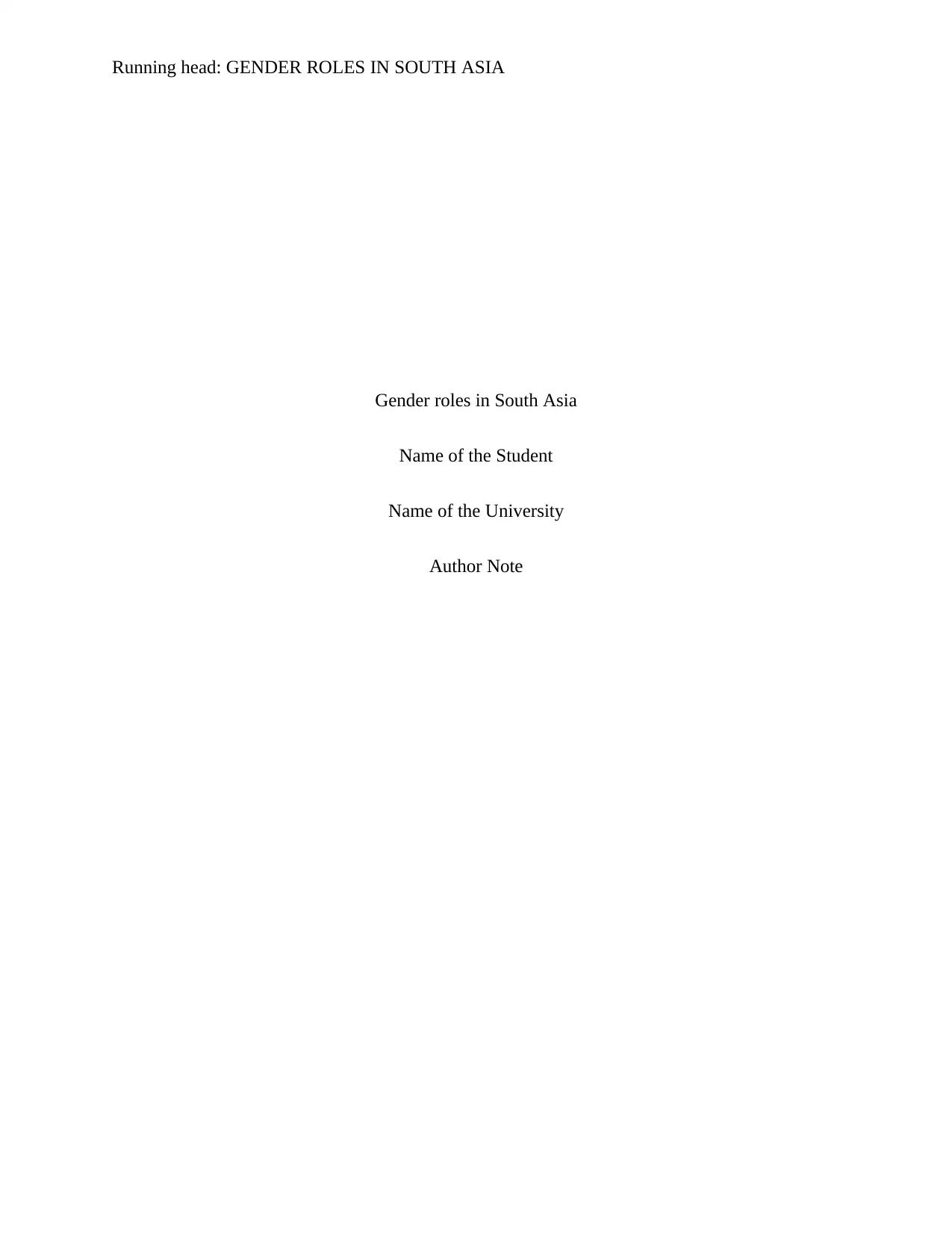
Running head: GENDER ROLES IN SOUTH ASIA
Gender roles in South Asia
Name of the Student
Name of the University
Author Note
Gender roles in South Asia
Name of the Student
Name of the University
Author Note
Paraphrase This Document
Need a fresh take? Get an instant paraphrase of this document with our AI Paraphraser
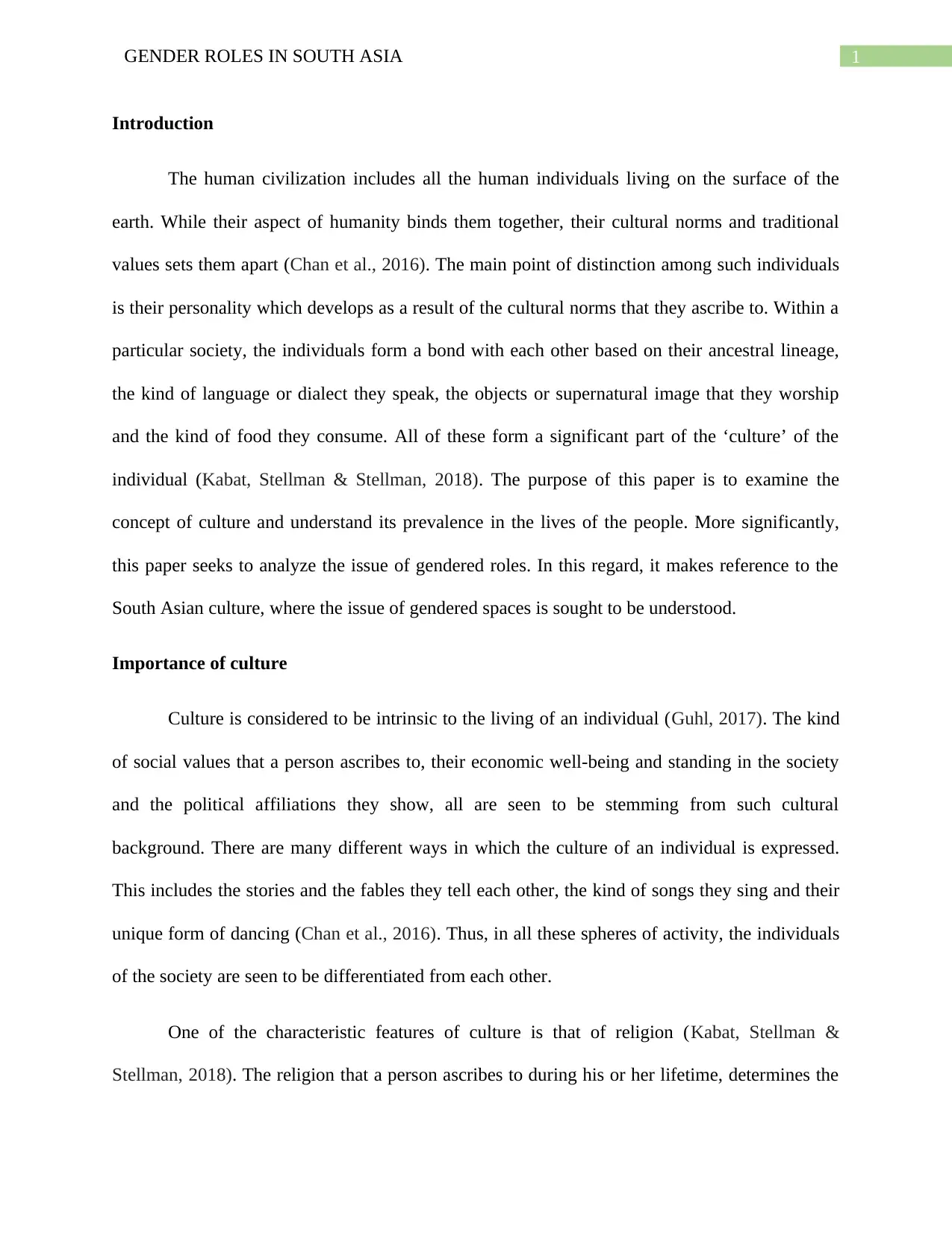
1GENDER ROLES IN SOUTH ASIA
Introduction
The human civilization includes all the human individuals living on the surface of the
earth. While their aspect of humanity binds them together, their cultural norms and traditional
values sets them apart (Chan et al., 2016). The main point of distinction among such individuals
is their personality which develops as a result of the cultural norms that they ascribe to. Within a
particular society, the individuals form a bond with each other based on their ancestral lineage,
the kind of language or dialect they speak, the objects or supernatural image that they worship
and the kind of food they consume. All of these form a significant part of the ‘culture’ of the
individual (Kabat, Stellman & Stellman, 2018). The purpose of this paper is to examine the
concept of culture and understand its prevalence in the lives of the people. More significantly,
this paper seeks to analyze the issue of gendered roles. In this regard, it makes reference to the
South Asian culture, where the issue of gendered spaces is sought to be understood.
Importance of culture
Culture is considered to be intrinsic to the living of an individual (Guhl, 2017). The kind
of social values that a person ascribes to, their economic well-being and standing in the society
and the political affiliations they show, all are seen to be stemming from such cultural
background. There are many different ways in which the culture of an individual is expressed.
This includes the stories and the fables they tell each other, the kind of songs they sing and their
unique form of dancing (Chan et al., 2016). Thus, in all these spheres of activity, the individuals
of the society are seen to be differentiated from each other.
One of the characteristic features of culture is that of religion (Kabat, Stellman &
Stellman, 2018). The religion that a person ascribes to during his or her lifetime, determines the
Introduction
The human civilization includes all the human individuals living on the surface of the
earth. While their aspect of humanity binds them together, their cultural norms and traditional
values sets them apart (Chan et al., 2016). The main point of distinction among such individuals
is their personality which develops as a result of the cultural norms that they ascribe to. Within a
particular society, the individuals form a bond with each other based on their ancestral lineage,
the kind of language or dialect they speak, the objects or supernatural image that they worship
and the kind of food they consume. All of these form a significant part of the ‘culture’ of the
individual (Kabat, Stellman & Stellman, 2018). The purpose of this paper is to examine the
concept of culture and understand its prevalence in the lives of the people. More significantly,
this paper seeks to analyze the issue of gendered roles. In this regard, it makes reference to the
South Asian culture, where the issue of gendered spaces is sought to be understood.
Importance of culture
Culture is considered to be intrinsic to the living of an individual (Guhl, 2017). The kind
of social values that a person ascribes to, their economic well-being and standing in the society
and the political affiliations they show, all are seen to be stemming from such cultural
background. There are many different ways in which the culture of an individual is expressed.
This includes the stories and the fables they tell each other, the kind of songs they sing and their
unique form of dancing (Chan et al., 2016). Thus, in all these spheres of activity, the individuals
of the society are seen to be differentiated from each other.
One of the characteristic features of culture is that of religion (Kabat, Stellman &
Stellman, 2018). The religion that a person ascribes to during his or her lifetime, determines the
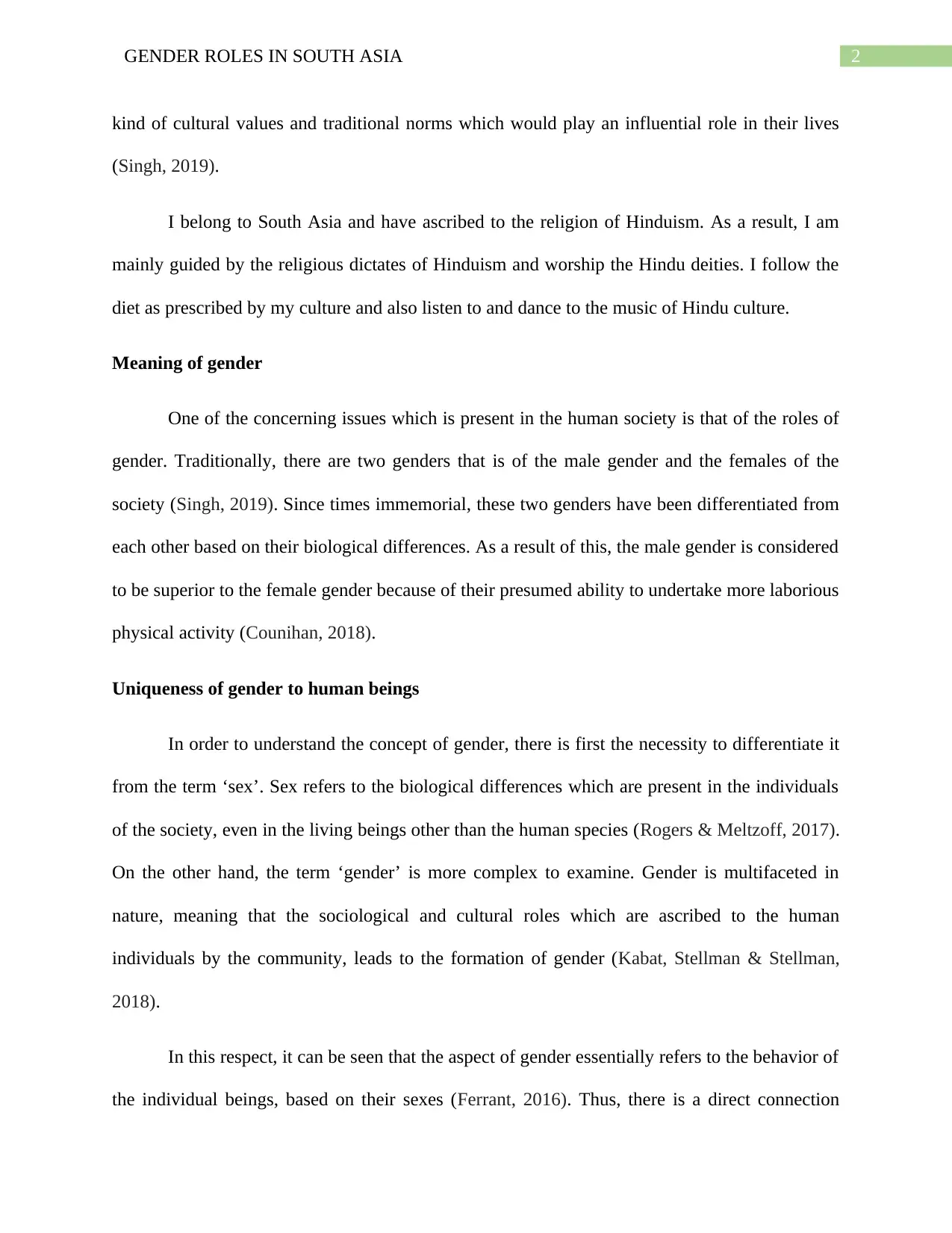
2GENDER ROLES IN SOUTH ASIA
kind of cultural values and traditional norms which would play an influential role in their lives
(Singh, 2019).
I belong to South Asia and have ascribed to the religion of Hinduism. As a result, I am
mainly guided by the religious dictates of Hinduism and worship the Hindu deities. I follow the
diet as prescribed by my culture and also listen to and dance to the music of Hindu culture.
Meaning of gender
One of the concerning issues which is present in the human society is that of the roles of
gender. Traditionally, there are two genders that is of the male gender and the females of the
society (Singh, 2019). Since times immemorial, these two genders have been differentiated from
each other based on their biological differences. As a result of this, the male gender is considered
to be superior to the female gender because of their presumed ability to undertake more laborious
physical activity (Counihan, 2018).
Uniqueness of gender to human beings
In order to understand the concept of gender, there is first the necessity to differentiate it
from the term ‘sex’. Sex refers to the biological differences which are present in the individuals
of the society, even in the living beings other than the human species (Rogers & Meltzoff, 2017).
On the other hand, the term ‘gender’ is more complex to examine. Gender is multifaceted in
nature, meaning that the sociological and cultural roles which are ascribed to the human
individuals by the community, leads to the formation of gender (Kabat, Stellman & Stellman,
2018).
In this respect, it can be seen that the aspect of gender essentially refers to the behavior of
the individual beings, based on their sexes (Ferrant, 2016). Thus, there is a direct connection
kind of cultural values and traditional norms which would play an influential role in their lives
(Singh, 2019).
I belong to South Asia and have ascribed to the religion of Hinduism. As a result, I am
mainly guided by the religious dictates of Hinduism and worship the Hindu deities. I follow the
diet as prescribed by my culture and also listen to and dance to the music of Hindu culture.
Meaning of gender
One of the concerning issues which is present in the human society is that of the roles of
gender. Traditionally, there are two genders that is of the male gender and the females of the
society (Singh, 2019). Since times immemorial, these two genders have been differentiated from
each other based on their biological differences. As a result of this, the male gender is considered
to be superior to the female gender because of their presumed ability to undertake more laborious
physical activity (Counihan, 2018).
Uniqueness of gender to human beings
In order to understand the concept of gender, there is first the necessity to differentiate it
from the term ‘sex’. Sex refers to the biological differences which are present in the individuals
of the society, even in the living beings other than the human species (Rogers & Meltzoff, 2017).
On the other hand, the term ‘gender’ is more complex to examine. Gender is multifaceted in
nature, meaning that the sociological and cultural roles which are ascribed to the human
individuals by the community, leads to the formation of gender (Kabat, Stellman & Stellman,
2018).
In this respect, it can be seen that the aspect of gender essentially refers to the behavior of
the individual beings, based on their sexes (Ferrant, 2016). Thus, there is a direct connection
⊘ This is a preview!⊘
Do you want full access?
Subscribe today to unlock all pages.

Trusted by 1+ million students worldwide
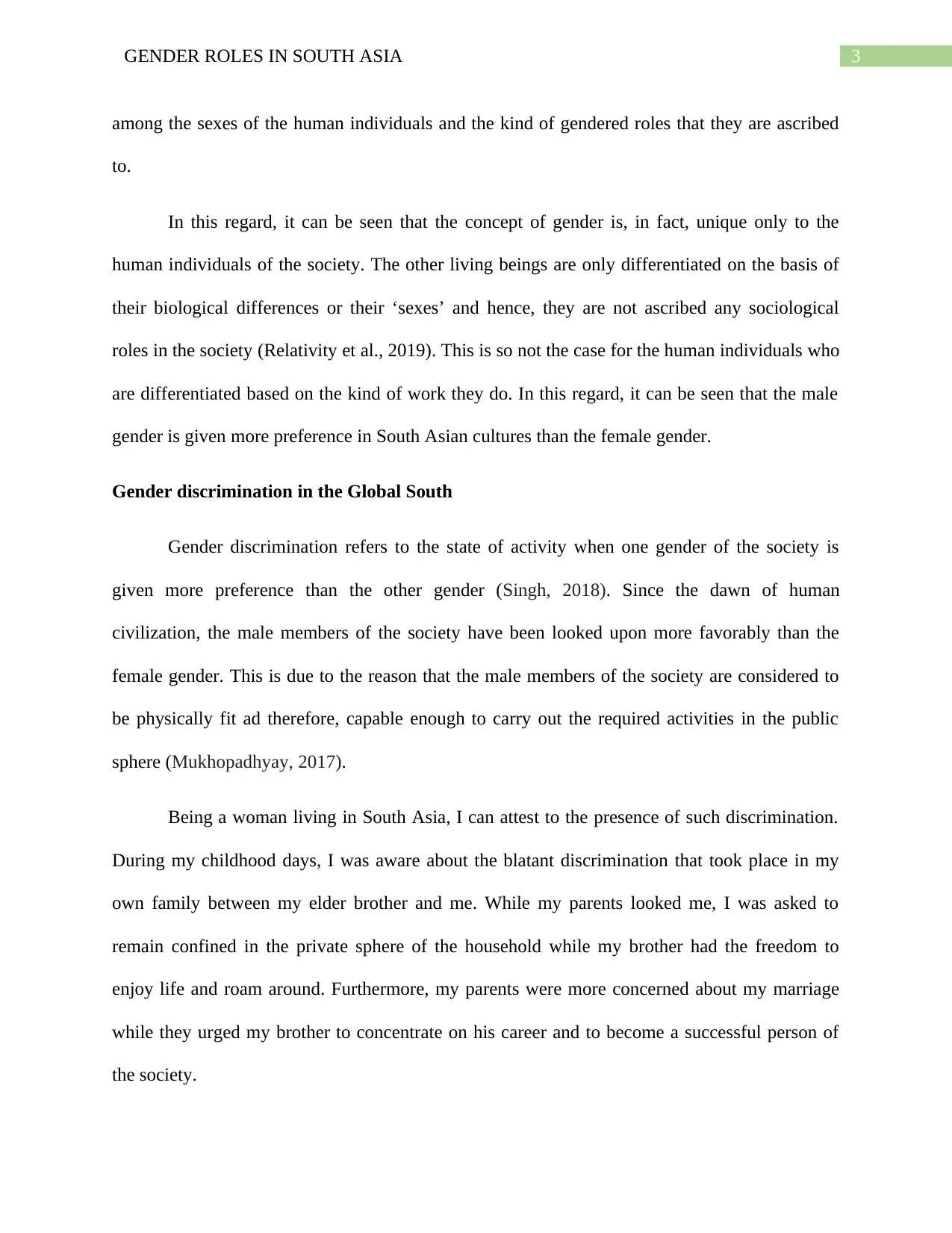
3GENDER ROLES IN SOUTH ASIA
among the sexes of the human individuals and the kind of gendered roles that they are ascribed
to.
In this regard, it can be seen that the concept of gender is, in fact, unique only to the
human individuals of the society. The other living beings are only differentiated on the basis of
their biological differences or their ‘sexes’ and hence, they are not ascribed any sociological
roles in the society (Relativity et al., 2019). This is so not the case for the human individuals who
are differentiated based on the kind of work they do. In this regard, it can be seen that the male
gender is given more preference in South Asian cultures than the female gender.
Gender discrimination in the Global South
Gender discrimination refers to the state of activity when one gender of the society is
given more preference than the other gender (Singh, 2018). Since the dawn of human
civilization, the male members of the society have been looked upon more favorably than the
female gender. This is due to the reason that the male members of the society are considered to
be physically fit ad therefore, capable enough to carry out the required activities in the public
sphere (Mukhopadhyay, 2017).
Being a woman living in South Asia, I can attest to the presence of such discrimination.
During my childhood days, I was aware about the blatant discrimination that took place in my
own family between my elder brother and me. While my parents looked me, I was asked to
remain confined in the private sphere of the household while my brother had the freedom to
enjoy life and roam around. Furthermore, my parents were more concerned about my marriage
while they urged my brother to concentrate on his career and to become a successful person of
the society.
among the sexes of the human individuals and the kind of gendered roles that they are ascribed
to.
In this regard, it can be seen that the concept of gender is, in fact, unique only to the
human individuals of the society. The other living beings are only differentiated on the basis of
their biological differences or their ‘sexes’ and hence, they are not ascribed any sociological
roles in the society (Relativity et al., 2019). This is so not the case for the human individuals who
are differentiated based on the kind of work they do. In this regard, it can be seen that the male
gender is given more preference in South Asian cultures than the female gender.
Gender discrimination in the Global South
Gender discrimination refers to the state of activity when one gender of the society is
given more preference than the other gender (Singh, 2018). Since the dawn of human
civilization, the male members of the society have been looked upon more favorably than the
female gender. This is due to the reason that the male members of the society are considered to
be physically fit ad therefore, capable enough to carry out the required activities in the public
sphere (Mukhopadhyay, 2017).
Being a woman living in South Asia, I can attest to the presence of such discrimination.
During my childhood days, I was aware about the blatant discrimination that took place in my
own family between my elder brother and me. While my parents looked me, I was asked to
remain confined in the private sphere of the household while my brother had the freedom to
enjoy life and roam around. Furthermore, my parents were more concerned about my marriage
while they urged my brother to concentrate on his career and to become a successful person of
the society.
Paraphrase This Document
Need a fresh take? Get an instant paraphrase of this document with our AI Paraphraser
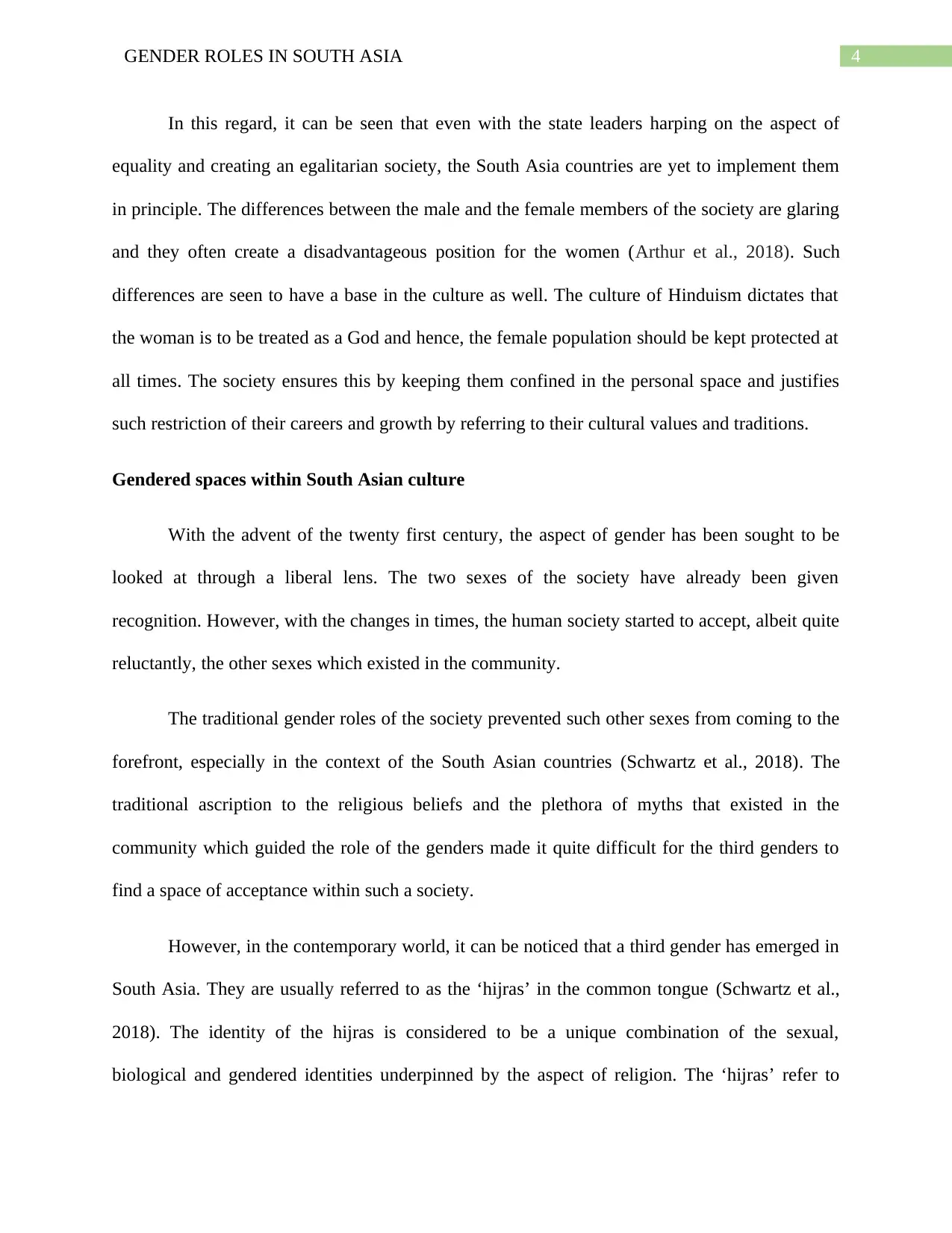
4GENDER ROLES IN SOUTH ASIA
In this regard, it can be seen that even with the state leaders harping on the aspect of
equality and creating an egalitarian society, the South Asia countries are yet to implement them
in principle. The differences between the male and the female members of the society are glaring
and they often create a disadvantageous position for the women (Arthur et al., 2018). Such
differences are seen to have a base in the culture as well. The culture of Hinduism dictates that
the woman is to be treated as a God and hence, the female population should be kept protected at
all times. The society ensures this by keeping them confined in the personal space and justifies
such restriction of their careers and growth by referring to their cultural values and traditions.
Gendered spaces within South Asian culture
With the advent of the twenty first century, the aspect of gender has been sought to be
looked at through a liberal lens. The two sexes of the society have already been given
recognition. However, with the changes in times, the human society started to accept, albeit quite
reluctantly, the other sexes which existed in the community.
The traditional gender roles of the society prevented such other sexes from coming to the
forefront, especially in the context of the South Asian countries (Schwartz et al., 2018). The
traditional ascription to the religious beliefs and the plethora of myths that existed in the
community which guided the role of the genders made it quite difficult for the third genders to
find a space of acceptance within such a society.
However, in the contemporary world, it can be noticed that a third gender has emerged in
South Asia. They are usually referred to as the ‘hijras’ in the common tongue (Schwartz et al.,
2018). The identity of the hijras is considered to be a unique combination of the sexual,
biological and gendered identities underpinned by the aspect of religion. The ‘hijras’ refer to
In this regard, it can be seen that even with the state leaders harping on the aspect of
equality and creating an egalitarian society, the South Asia countries are yet to implement them
in principle. The differences between the male and the female members of the society are glaring
and they often create a disadvantageous position for the women (Arthur et al., 2018). Such
differences are seen to have a base in the culture as well. The culture of Hinduism dictates that
the woman is to be treated as a God and hence, the female population should be kept protected at
all times. The society ensures this by keeping them confined in the personal space and justifies
such restriction of their careers and growth by referring to their cultural values and traditions.
Gendered spaces within South Asian culture
With the advent of the twenty first century, the aspect of gender has been sought to be
looked at through a liberal lens. The two sexes of the society have already been given
recognition. However, with the changes in times, the human society started to accept, albeit quite
reluctantly, the other sexes which existed in the community.
The traditional gender roles of the society prevented such other sexes from coming to the
forefront, especially in the context of the South Asian countries (Schwartz et al., 2018). The
traditional ascription to the religious beliefs and the plethora of myths that existed in the
community which guided the role of the genders made it quite difficult for the third genders to
find a space of acceptance within such a society.
However, in the contemporary world, it can be noticed that a third gender has emerged in
South Asia. They are usually referred to as the ‘hijras’ in the common tongue (Schwartz et al.,
2018). The identity of the hijras is considered to be a unique combination of the sexual,
biological and gendered identities underpinned by the aspect of religion. The ‘hijras’ refer to
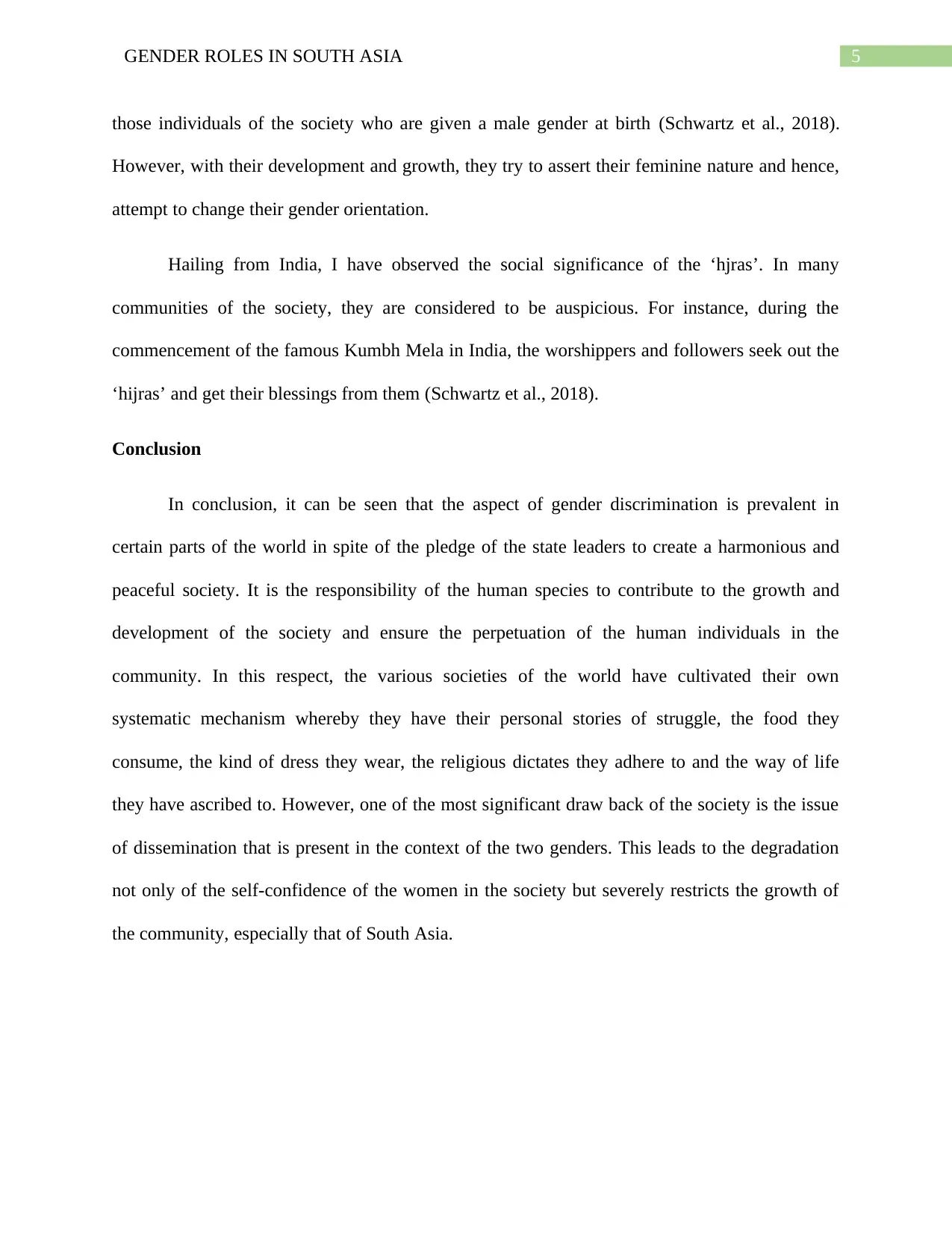
5GENDER ROLES IN SOUTH ASIA
those individuals of the society who are given a male gender at birth (Schwartz et al., 2018).
However, with their development and growth, they try to assert their feminine nature and hence,
attempt to change their gender orientation.
Hailing from India, I have observed the social significance of the ‘hjras’. In many
communities of the society, they are considered to be auspicious. For instance, during the
commencement of the famous Kumbh Mela in India, the worshippers and followers seek out the
‘hijras’ and get their blessings from them (Schwartz et al., 2018).
Conclusion
In conclusion, it can be seen that the aspect of gender discrimination is prevalent in
certain parts of the world in spite of the pledge of the state leaders to create a harmonious and
peaceful society. It is the responsibility of the human species to contribute to the growth and
development of the society and ensure the perpetuation of the human individuals in the
community. In this respect, the various societies of the world have cultivated their own
systematic mechanism whereby they have their personal stories of struggle, the food they
consume, the kind of dress they wear, the religious dictates they adhere to and the way of life
they have ascribed to. However, one of the most significant draw back of the society is the issue
of dissemination that is present in the context of the two genders. This leads to the degradation
not only of the self-confidence of the women in the society but severely restricts the growth of
the community, especially that of South Asia.
those individuals of the society who are given a male gender at birth (Schwartz et al., 2018).
However, with their development and growth, they try to assert their feminine nature and hence,
attempt to change their gender orientation.
Hailing from India, I have observed the social significance of the ‘hjras’. In many
communities of the society, they are considered to be auspicious. For instance, during the
commencement of the famous Kumbh Mela in India, the worshippers and followers seek out the
‘hijras’ and get their blessings from them (Schwartz et al., 2018).
Conclusion
In conclusion, it can be seen that the aspect of gender discrimination is prevalent in
certain parts of the world in spite of the pledge of the state leaders to create a harmonious and
peaceful society. It is the responsibility of the human species to contribute to the growth and
development of the society and ensure the perpetuation of the human individuals in the
community. In this respect, the various societies of the world have cultivated their own
systematic mechanism whereby they have their personal stories of struggle, the food they
consume, the kind of dress they wear, the religious dictates they adhere to and the way of life
they have ascribed to. However, one of the most significant draw back of the society is the issue
of dissemination that is present in the context of the two genders. This leads to the degradation
not only of the self-confidence of the women in the society but severely restricts the growth of
the community, especially that of South Asia.
⊘ This is a preview!⊘
Do you want full access?
Subscribe today to unlock all pages.

Trusted by 1+ million students worldwide
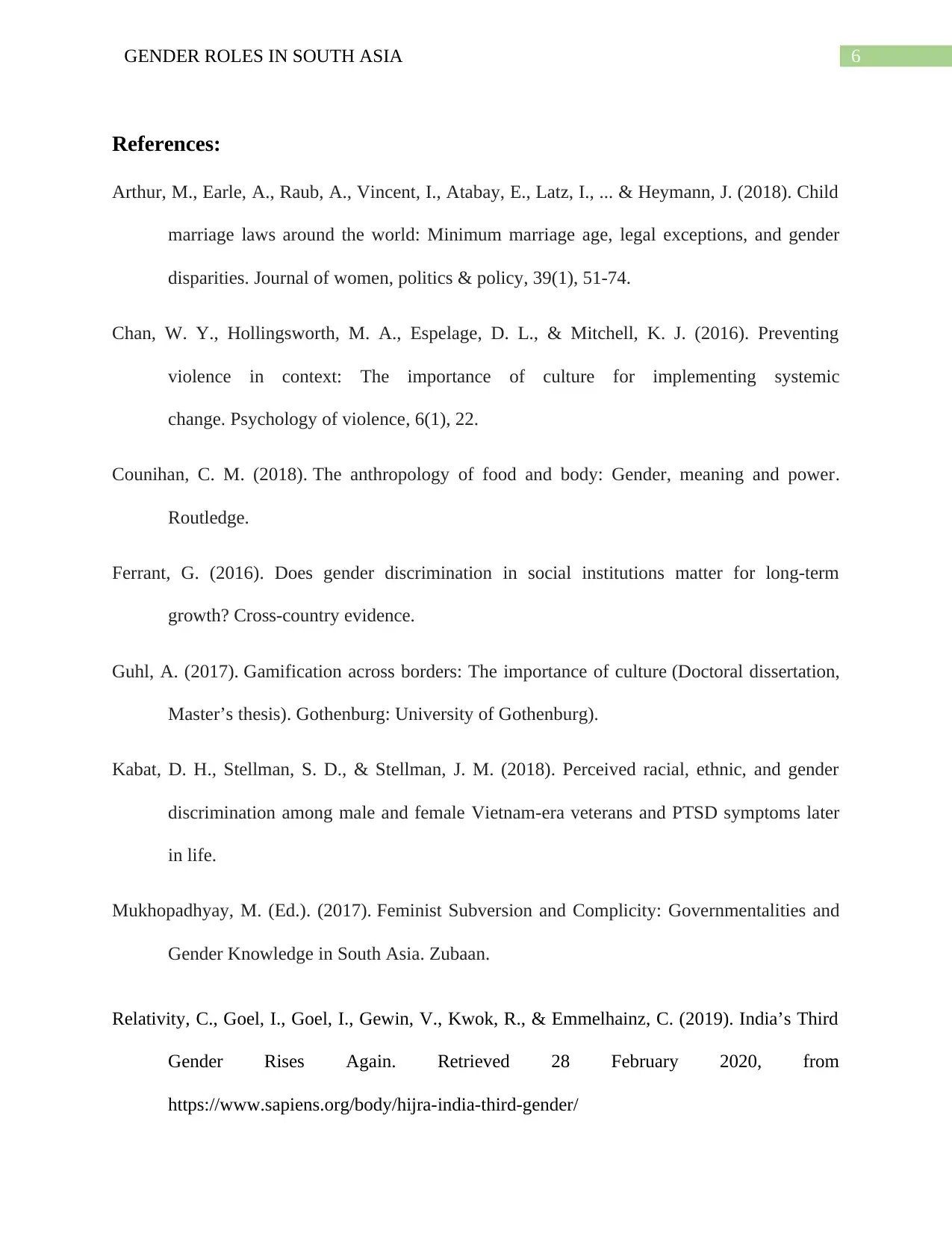
6GENDER ROLES IN SOUTH ASIA
References:
Arthur, M., Earle, A., Raub, A., Vincent, I., Atabay, E., Latz, I., ... & Heymann, J. (2018). Child
marriage laws around the world: Minimum marriage age, legal exceptions, and gender
disparities. Journal of women, politics & policy, 39(1), 51-74.
Chan, W. Y., Hollingsworth, M. A., Espelage, D. L., & Mitchell, K. J. (2016). Preventing
violence in context: The importance of culture for implementing systemic
change. Psychology of violence, 6(1), 22.
Counihan, C. M. (2018). The anthropology of food and body: Gender, meaning and power.
Routledge.
Ferrant, G. (2016). Does gender discrimination in social institutions matter for long-term
growth? Cross-country evidence.
Guhl, A. (2017). Gamification across borders: The importance of culture (Doctoral dissertation,
Master’s thesis). Gothenburg: University of Gothenburg).
Kabat, D. H., Stellman, S. D., & Stellman, J. M. (2018). Perceived racial, ethnic, and gender
discrimination among male and female Vietnam-era veterans and PTSD symptoms later
in life.
Mukhopadhyay, M. (Ed.). (2017). Feminist Subversion and Complicity: Governmentalities and
Gender Knowledge in South Asia. Zubaan.
Relativity, C., Goel, I., Goel, I., Gewin, V., Kwok, R., & Emmelhainz, C. (2019). India’s Third
Gender Rises Again. Retrieved 28 February 2020, from
https://www.sapiens.org/body/hijra-india-third-gender/
References:
Arthur, M., Earle, A., Raub, A., Vincent, I., Atabay, E., Latz, I., ... & Heymann, J. (2018). Child
marriage laws around the world: Minimum marriage age, legal exceptions, and gender
disparities. Journal of women, politics & policy, 39(1), 51-74.
Chan, W. Y., Hollingsworth, M. A., Espelage, D. L., & Mitchell, K. J. (2016). Preventing
violence in context: The importance of culture for implementing systemic
change. Psychology of violence, 6(1), 22.
Counihan, C. M. (2018). The anthropology of food and body: Gender, meaning and power.
Routledge.
Ferrant, G. (2016). Does gender discrimination in social institutions matter for long-term
growth? Cross-country evidence.
Guhl, A. (2017). Gamification across borders: The importance of culture (Doctoral dissertation,
Master’s thesis). Gothenburg: University of Gothenburg).
Kabat, D. H., Stellman, S. D., & Stellman, J. M. (2018). Perceived racial, ethnic, and gender
discrimination among male and female Vietnam-era veterans and PTSD symptoms later
in life.
Mukhopadhyay, M. (Ed.). (2017). Feminist Subversion and Complicity: Governmentalities and
Gender Knowledge in South Asia. Zubaan.
Relativity, C., Goel, I., Goel, I., Gewin, V., Kwok, R., & Emmelhainz, C. (2019). India’s Third
Gender Rises Again. Retrieved 28 February 2020, from
https://www.sapiens.org/body/hijra-india-third-gender/
Paraphrase This Document
Need a fresh take? Get an instant paraphrase of this document with our AI Paraphraser
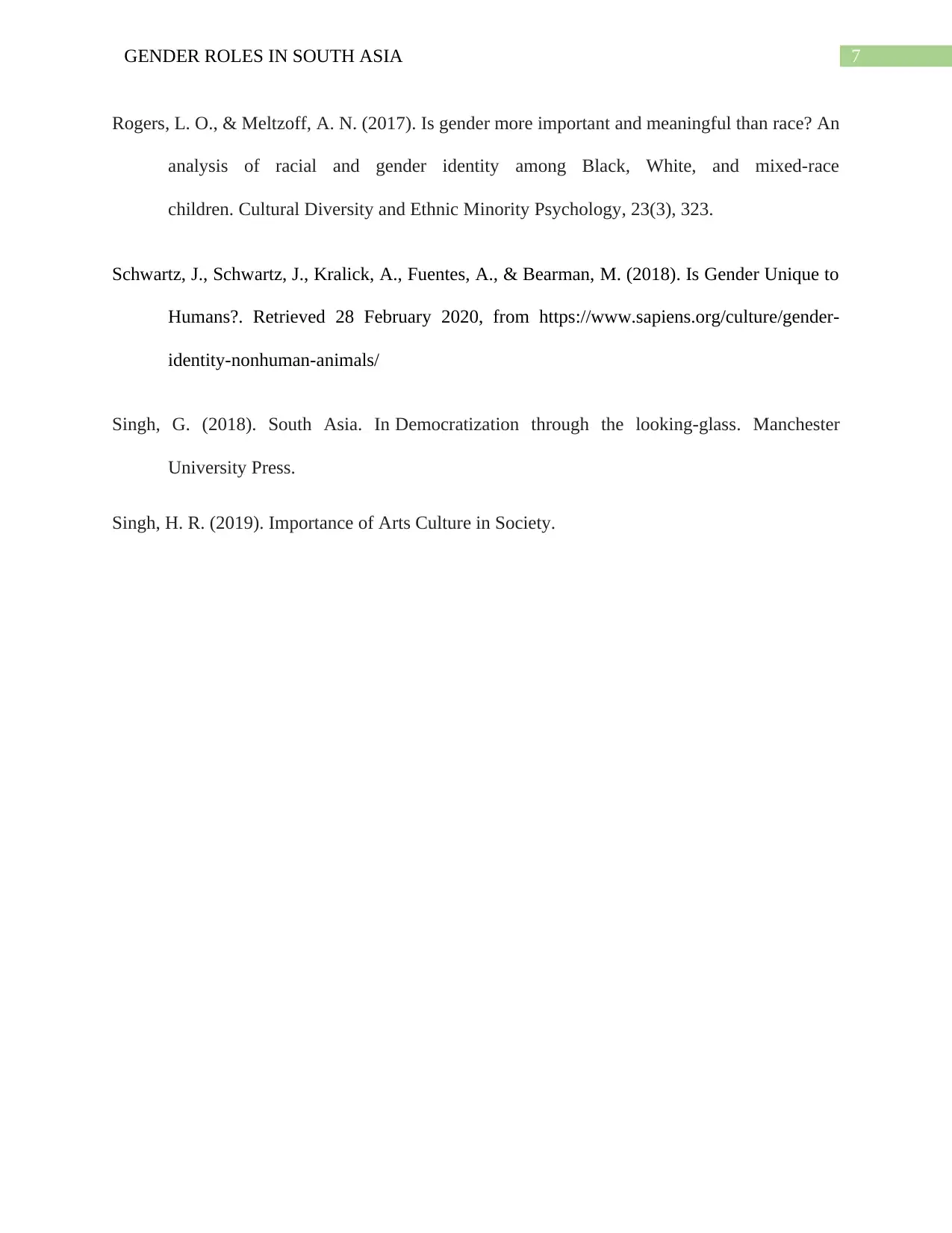
7GENDER ROLES IN SOUTH ASIA
Rogers, L. O., & Meltzoff, A. N. (2017). Is gender more important and meaningful than race? An
analysis of racial and gender identity among Black, White, and mixed-race
children. Cultural Diversity and Ethnic Minority Psychology, 23(3), 323.
Schwartz, J., Schwartz, J., Kralick, A., Fuentes, A., & Bearman, M. (2018). Is Gender Unique to
Humans?. Retrieved 28 February 2020, from https://www.sapiens.org/culture/gender-
identity-nonhuman-animals/
Singh, G. (2018). South Asia. In Democratization through the looking-glass. Manchester
University Press.
Singh, H. R. (2019). Importance of Arts Culture in Society.
Rogers, L. O., & Meltzoff, A. N. (2017). Is gender more important and meaningful than race? An
analysis of racial and gender identity among Black, White, and mixed-race
children. Cultural Diversity and Ethnic Minority Psychology, 23(3), 323.
Schwartz, J., Schwartz, J., Kralick, A., Fuentes, A., & Bearman, M. (2018). Is Gender Unique to
Humans?. Retrieved 28 February 2020, from https://www.sapiens.org/culture/gender-
identity-nonhuman-animals/
Singh, G. (2018). South Asia. In Democratization through the looking-glass. Manchester
University Press.
Singh, H. R. (2019). Importance of Arts Culture in Society.
1 out of 8
Your All-in-One AI-Powered Toolkit for Academic Success.
+13062052269
info@desklib.com
Available 24*7 on WhatsApp / Email
![[object Object]](/_next/static/media/star-bottom.7253800d.svg)
Unlock your academic potential
Copyright © 2020–2025 A2Z Services. All Rights Reserved. Developed and managed by ZUCOL.

